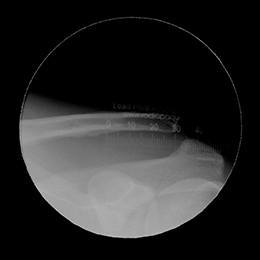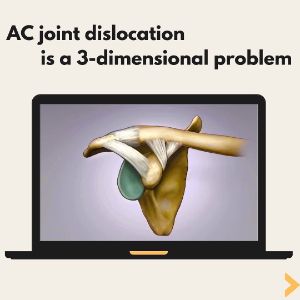Introduction
Like many orthopedic conditions, AC joint separations can range from mild to very severe. Treatment is often based on grading based on a standard x-ray. The original grading system had three grades; non-displaced sprain (type 1), partially dislocated joint (type 2) and completely dislocated (type 3).
A more detailed classification system (Rockwood) is now more popular and is based on 6 levels of severity. In the Rockwood system the first two grades are the same as the original grading system, but a complete ac separation has now been subdivided into 4 subclasses. While all 4 subclasses represent a complete ac joint separation each type, they differ by the amount and the direction of displacement of the clavicle relative to the coracoid bone.

A grade 3 ac separation and a grade 5 ac separation are both determined by the amount of vertical movement of the clavicle relative to the coracoid bone. The injured side must be compared to the non-injured side in order to determine the grade. If the distance between the two bones is between increased between 25 and 100% it is a grade 3 and if it is more than that it is a grade 5. A grade 4 ac separation is one where there is significant posterior movement of the clavicle relative to the acromion. Finally a grade 6 ac separation is when the clavicle is displaced under the coracoid process. A grade 6 is an extremely rare injury and has been reported less than 10 times in the literature.
If this grading scheme seems complicated, unwieldy and somewhat unreliable it’s because it is. Numerous studies have demonstrated that when groups of experienced orthopedic surgeons were asked to grade AC joint separation injuries based on standard x-rays there was considerable differences of opinion. Even when 3 dimensional CT scan imaging was utilized there were still significant differences of opinion about the severity of injury. This has powerful clinical significance because the decision for surgical versus a non-surgical initial treatment approach is highly dependent on the initial grading.
How to accurately determine AC joint injury grade

In order to determine the grade of injury it is essential that both the normal and the abnormal side be imaged. This involves both the standard “Zanca” view (for vertical movement) as well as an axillary view to determine horizontal movement. Accuracy is significantly improved when the measurements are done through digital analysis of the x-rays. Stress views are painful, and have not proven to be of additional value and neither necessary or recommended routinely.
Treatment significance
Currently with regard to the common subtypes of complete AC joint separation (grades 3, 4, and 5) there is no evidence that treatment outcome is affected by injury grade. It is commonly stated that a grade 4 or 5 shoulder separation should be treated surgically and a grade 3 shoulder separation should only be treated surgically in a young or athletically inclined patient. This approach while logical has never actually been validated in any mainstream clinical article to date.
Conclusion
While objective grading of an AC joint separation is important, current methods and grading systems are not well defined and not very accurate. It is extremely important to get x-rays of both the affected and normal side and when possible use digital measurements to determine severity. Grading is but one of many factors to be considered in clinical decision making, particularly the decision as to whether or not to recommend ac joint surgery.
Contact us today to schedule your consultation with Dr. Struhl.




